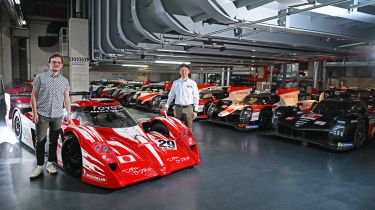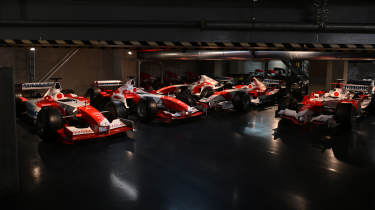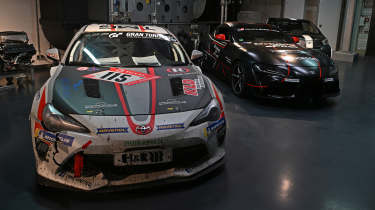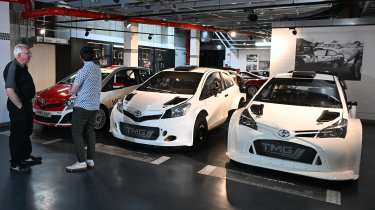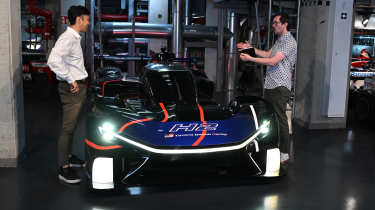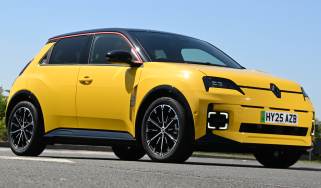What is Toyota GR? Past, present and future of the Gazoo Racing brand
Inside look at Toyota GR, the “Meisters of the Nurburgring”
Gazoo might sound as if it comes straight from the Black Lace songbook, but in fact it’s Toyota’s performance brand, which has gone from zero to hero in just under a decade, securing wins on both road and track.
What is it, though, what makes it special, and why does it have such a strange-sounding name? To find out, we got behind the wheel of arguably Gazoo’s finest creation, the GR Yaris, and headed to the firm’s headquarters in Cologne, Germany, for an exclusive tour of its development facilities and historic racing museum.
What is Gazoo Racing?
Producing cars for both keen drivers and the upper echelons of motorsport, Gazoo Racing is Toyota’s motorsport division. However, those familiar with the manufacturer's history will know that it’s not the only one, nor is it the first.
GR was founded in 2007, and Toyota’s previous racing and road car achievements can be attributed to both Toyota Motorsport GmbH (TMG) and Toyota Racing Development (TRD) respectively, both formed years earlier.
With Toyota having already secured victories in rallying through the Celica and Corolla, plus strong finishes in sportscar racing (including Le Mans) with the GT-One, Gazoo Racing arrived at a time when TMG was struggling with its entry into Formula One; Toyota was bleeding cash and off the leading pace, despite having drivers of the calibre of Ralf Schumacher and Timo Glock.
GR was originally devised as a means to train up junior mechanics, with the goal of entering the Nürburgring 24 Hours race, and Toyota’s so-called Master Driver, Hiromu Naruse, was called in to supervise. The concept of a Master Driver might seem a bit cheesy, but it’s something Toyota takes very seriously, with the person bearing this title getting final say on the driving dynamics of the firm’s cars.
We sat down with GR’s current Vice chairman, and three-time Le Mans winner, Kazuki Nakajima, who told us, “Having a Master Driver is what makes Gazoo Racing really stand out.” Today, Toyota’s Master Driver is Akio Toyoda, the grandson of the company’s founder and sitting president. But it was only through intense training under Naruse that Toyoda was able to gain this title and take on his racing pseudonym, Morizo.
Nakajima famously told his corporate bosses, “Somebody in [his] position, who doesn’t know the first thing about driving, shouldn’t make passing comments about cars. The least [he] can do is learn how to drive.”
While such a comment in any other scenario would have resulted in the test driver being fired, the Japanese hold the utmost respect for racing drivers and their skills. This being the case, Naruse instead took Toyoda under his wing, setting him on a path of transformation. This would take him from what some might perceive as a company executive who'd gained his status thanks to his family connections, to the next ‘Master Driver’, and stepping into the racing seat himself.
“What’s important for GR is that we always have our Master Driver,” Nakajima said. “We can clearly say that [Morizo] is a true car lover. I mean the passion he has for driving, as well as his capability to feel the car properly, is real.”
Why is it called Gazoo Racing?
Gazoo Racing got its name from a website Toyota was operating at the time; Gazoo.com was set up in the mid-2000s to sell second-hand Toyotas using photographs posted online. The name Gazoo itself is derived from the Japanese word for “picture”, and given that the name “Toyota Racing” was already taken, Naruse and Morizo went with GR instead.
While GR’s first racing entry in the 2007 Nürburgring 24 Hours was unexceptional – Team Gazoo finished a mediocre 104th – it still sparked the idea that racing could be an invaluable tool for developing road cars. With this in mind, Gazoo returned to the Nürburgring the following year with a mysterious development car, which bore the designation LFA.
Yes, that’s right; Gazoo Racing was very much involved with the development of what has become one of the most beloved modern supercars: the shrieking V10-powered Lexus LFA. Following this, Gazoo also raced pre-production versions of the Toyota GT86 – another lauded future classic – and continues to compete in the Nürburgring 24 Hours to this day.
Nakajima told us that the philosophy of racing closely mirrors that of the GR development team, explaining that “The cycle of ‘Push the limit, break the car, fix the car’, which we use in motorsport, is exactly the same as what’s used on the road car side. Because of this endless effort, our product is getting better and better, and it’s nice to see that customers feel that and share our excitement.”
However, disaster struck in 2010 when Naruse was testing the hardcore Nürburgring Edition of the LFA and suffered a fatal crash. Morizo reflected on the early days of Gazoo with Naruse, saying, “Back then, I was overcome by various disappointments: the disappointment of not receiving any support; the disappointment of not being taken seriously, no matter what we did; [and] the disappointment of being belittled, no matter what we did.”
Morizo said that such disappointments are the reason why he champions the phrase “let us make ever-better cars”, and the team at GR appeared to take this rather literally, spending the next few years tinkering around and developing a hardcore version of the GT86.
What was the first GR car?
With Morizo designating Gazoo Racing as Toyota’s official performance arm in 2015, the Japan-only, limited-edition GT86 GRMN (Gazoo Racing, Meisters of the Nürburgring) took learnings from Gazoo's time endurance racing with the GT86. It boasted more power than the regular car, along with a custom crankshaft, upgraded suspension, bucket seats and a fairly lairy aero kit.
However, it wasn’t the first car to wear the GRMN designation; that was, would you believe, a souped-up version of the iQ city car. Like the GT86, this was limited to 100 models and was only sold in Japan; unlike the GT86, however, a second version was sold later, packing a supercharger and more punch.
The UK’s first experience of Gazoo was the Yaris GRMN, which was limited to just 600 units worldwide and like other models from Toyota’s performance arm, got a heavily revised chassis compared with the standard model. Putting out a healthy 209bhp from its fruity-sounding 1.8-litre four-cylinder engine, the GRMN was a tantalising taster of what hot hatch buyers could expect from GR in just a few years.
Before then, however, Gazoo needed to make the jump from building limited-run specials to series-production performance models. That time came in 2018, with the GR Supra – the fifth generation of the long-running sports car and successor to the legendary A80 Supra.
Created in collaboration with BMW, the Toyota GR Supra was designed to be more focused than the soft-top Z4 with which it shared many of its parts – including the 3.0-litre straight-six petrol engine. Like a thoroughbred, the GR Supra has been developed to be as darty and frisky as possible, with a chassis that, according to Toyota, is more than two times stiffer than even the carbon-fibre tub used by the LFA.
Gazoo Racing’s motorsport success
Around the time of the Supra’s launch, Gazoo Racing was also making history because, after re-entering the World Endurance Championship (WEC) in 2012, the team won Le Mans in 2018. The winning car was piloted by Nakajima himself, with F1 legend Fernando Alonso, and F1 racer and future Formula E champion Sebastian Buemi.
From here on, GR’s racing success only grew, with two more consecutive Le Mans wins at the hands of Nakajima and team, as well as a win in the World Rally Championship (WRC) in 2018 with a rally-tuned version of the Yaris.
However, with WRC regulations about to change in 2020 and Toyota feeling a three-door bodystyle would suit its racing efforts the best, the team at Gazoo Racing was set to work to build a full-on homologation special version of the Yaris, similar to the likes of the Audi Sport Quattro and Peugeot 205 Turbo 16 decades before.
The result was the Toyota GR Yaris: one of the greatest modern hot hatches, or performance cars in general, for that matter. Yet despite an impressive 261bhp output (280bhp in updated models), benefitting from four-wheel drive and reaching 62mph in similar time to an Alfa Romeo Giulia Quadrifoglio, none of this is what’s most impressive about the hot Yaris.
You see, the GR Yaris shares only its lights, mirrors, and antenna with the standard car. Its roof is made of carbon fibre and the entire car sits roughly 6cm wider than the regular hybrid courtesy of aggressively flared wheelarches.
Bearing this in mind, Nakajima explained how the Yaris specifically, as well as the GR brand as a whole, “is symbolic because it [represents] a change of culture at Toyota, focusing less on the volume and cost-competitiveness of a car and more on making the best car possible.”
If you’ve never driven a GR Yaris, it’s important to try and convey how tactile an experience it is, and we certainly don’t mean that in a sense of the car being draped in plush, sumptuous materials – something which it most definitely isn’t.
The gearbox, for example, is superbly rewarding to operate, with the gearstick perfectly positioned, a short-yet-satisfying throw and emitting the sort of deep ‘clunk’ whenever you shift that would feel right at home in one of those ASMR videos you see and hear online.
Plus, despite its four-wheel drive system being electronically controlled – drivers can select Normal or Track settings to adjust the torque distribution – the sensation of the car shifting its power around in order to maintain maximum grip is palpable, with the Yaris’ rallying pedigree most evident when you’re pushing on through the tight, twisting roads of places like the Peak District, where we've explored the GR’s abilities.
What’s next for Gazoo Racing?
It’s no surprise, then, that the GR Yaris and its rallying success – three World Championships since 2022 – has turbocharged support for the Gazoo Racing brand; the hot Yaris, for example, has been notoriously hard for buyers to secure an allocation for, while the GR86 (the successor to the aforementioned GT86) made the ticket sales for the Oasis reunion tour seem slow, selling out in just 90 minutes.
Toyota knows this, though, and is beginning to lean heavily on the Gazoo brand with the launch of GR Sport trim levels across the company's line-up, bringing sportier styling and often mild chassis upgrades to more mainstream models.
But those whose appetites won’t be whetted by a somewhat sporty trim level now that production of the GR Yaris and GR86 has ended, should fear not; Auto Express recently revealed that the previously US-only GR Corolla will soon be available to UK buyers, with the car being built in Burnaston, Derbyshire, from next year.
In the longer term, however, the team at GR is looking at sustainability as part of Toyota’s ‘Multi-Path Solution’ approach. “There are a lot of interesting projects going on with which we can transfer our technology to [series] production,” Nakajima said. “For example, with powertrain engineers working on our H2 hydrogen [WEC] racing concept, this naturally creates conversations of how to bring this sort of technology to the road.”
Almost certain to have the GR badge when it reaches production, the FT-Se will be an electric sports car. Toyota has also hinted at a revival of the Celica and MR2 nameplates in the future.“For years, electric power [for Toyota] has been used for fuel economy, in both hybrids and EVs; as a driver, I think there’s a lot more to come, and a lot to play with to create some excitement,” Nakajima hinted.
Ultimately, GR’s rise to the top has been nothing short of incredible, especially given the short time in which it has been achieved. Toyota’s performance arm has managed to churn out future classics at such a speed that it makes the firm’s renowned factory Production System look inefficient in comparison.
Akio Toyoda is often quoted for his analogy of a tree, saying that “when unusually rapid growth causes the rings to grow abnormally thick, the trunk weakens and is easily broken”. And while this is certainly the case for most firms, the evident passion and expertise at Gazoo Racing are likely to mean it’ll be as solid as an oak for years to come.
Did you know you can sell your car with Auto Express? Get the highest bid from our network of over 5,500 dealers and we'll do the rest. Click here to try Auto Express Sell My Car now...
Find a car with the experts

